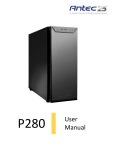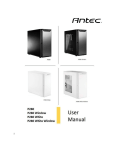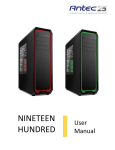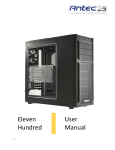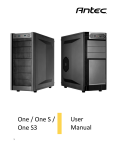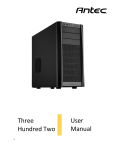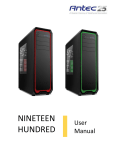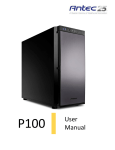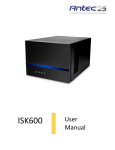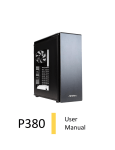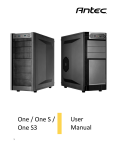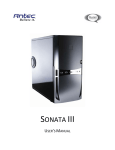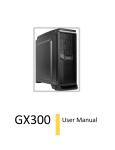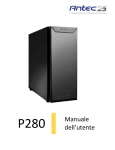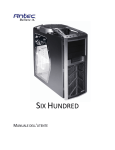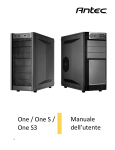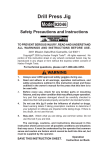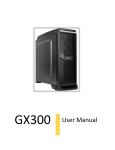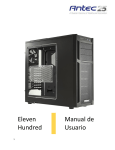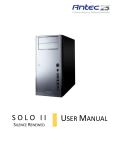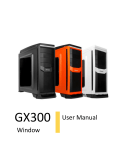Download User Manual - Newegg.com
Transcript
P280 User Manual P280 User Manual Congratulations on your purchase of the Antec P280! Sophisticated and cutting-edge, the P280 emphasizes the ease of use, quiet technology and unparalleled performance characteristic of Antec’s Performance One series. This advanced enclosure comes equipped with features that will maximize your PC experience, from Quiet Computing™ panels & HDD drive bays, to grommet-lined cable routing holes with ample space behind the motherboard tray. The P280 accommodates motherboards up to XL-ATX and includes nine expansion slots to support up to four 13.0” / 330 mm graphics cards. And with convenient tool-less optical drive bays, easy-access front & bottom PSU intake air filters, two front panel USB 3.0 ports and an affordable price, you get an elite enclosure that will last you for builds to come. The P280 does not include a power supply. Make sure you choose a power supply that is compatible with your computer components and has a long enough power harness to reach your motherboard and peripheral devices. We recommend our High Current Gamer, High Current Pro or EarthWatts power supplies for the latest ATX specification compliance, broad compatibility, and power savings capability. At Antec, we continually refine and improve our products to ensure the highest quality. As such, your new chassis may differ slightly from the description in this manual due to improvements applied for the optimal building experience. As of November 15, 2011, all features, descriptions, and illustrations in this manual are correct. Disclaimer This manual is intended only as a guide for Antec’s computer enclosures. For more comprehensive instructions on installing the motherboard and peripherals, please refer to the manuals that come with those components. 2 Table of Contents Section 1: Introduction 1.1 1.2 1.3 1.4 Getting to Know Your Chassis ............................................................................5 Chassis Specifications.........................................................................................6 Included Screws .................................................................................................6 Before You Begin................................................................................................7 Section 2: Hardware Installation 2.1 2.2 2.3 2.4 2.5 2.6 2.7 2.8 Setting Up ..........................................................................................................9 Motherboard Installation...................................................................................9 Installing KUHLER H2O Liquid Coolers ................................................................11 Power Supply Installation ..................................................................................12 External 5.25” Device Installation ......................................................................13 Internal 2.5” Device Installation ........................................................................14 Internal 3.5” / 2.5” Device Installation ..............................................................14 Cable Management ............................................................................................16 Section 3: Front I/O Ports 3.1 3.2 3.3 3.4 3.5 USB 2.0 ...............................................................................................................18 USB 3.0 ...............................................................................................................18 AC’97 / HD Audio Ports ......................................................................................19 Power Switch / Reset Switch / Hard Disk Drive LED Connectors .......................19 Rewiring Motherboard Header Connections .....................................................20 Section 4: Cooling System 4.1 4.2 4.3 3 Included Fans .....................................................................................................22 Optional Fans .....................................................................................................22 Air Filters ............................................................................................................24 Section 1 Introduction P280 User Manual 4 1.1 Getting to Know Your Chassis 1. 2. 3. 4. 5. 6. 7. 8. 9. 10. 11. 12. 5 3 x 5.25” tool-less drive bays 2 x 2.5” drive trays (dedicated) 6 x 3.5” / 2.5” drive trays 2 x 120 mm top TwoCool™ exhaust fans 1 x 120 mm rear TwoCool™ exhaust fan 2 x 120 mm internal intake fans (optional) 2 x 120 mm front intake fans (optional) 9 expansion slots CPU cutout Cable routing holes Motherboard mount: XL-ATX, Standard ATX, microATX or Mini-ITX Power supply mount / PSU intake filter Front Ports (USB 3.0, USB 2.0, Audio I/O) 1.2 Chassis Specifications Chassis Type Chassis Color Dimensions Weight Cooling Drive Bays Expansion Slots Motherboard Size Front I/O Panel 1.3 Super Mid-Tower Black with aluminum door 20.7” (H) x 9.1” (W) x 22.1” (D) 526 mm (H) x 231 mm (W) x 562 mm (D) 22.3 lbs / 10.2 kg - 2 x 120 mm top TwoCool™ exhaust fans - 1 x 120 mm rear TwoCool™ exhaust fan - 2 x 120 mm internal intake fans (optional) - 2 x 120 mm front intake fans (optional) - 3 x 5.25” tool-less drive bays - 6 x 3.5” / 2.5” drive trays - 2 x 2.5” drive-bays (dedicated) 9: supports up to 3-way NVIDIA® SLI® / AMD CrossFireX™ XL-ATX [13.6” x 10.3” (345 mm x 262 mm)], Standard ATX, microATX, Mini-ITX - 2 x USB 3.0 with internal motherboard connector - 2 x USB 2.0 - Audio In/Out - Power and Reset buttons located on top panel of chassis Included Screws An inventory of all screws and intended usage and quantity is provided here: A. B. C. D. E. F. G. H. Power supply screw (4) Motherboard standoff (4 included, 6 preinstalled) Motherboard screw (10) Optional 5.25” screw / dedicated 2.5” drive bay screw (6) 3.5” tray-mount screw (25) 2.5” tray-mount screw (8) Front fan screw (4) Not pictured: zip ties for cable management (6) A 6 B C D E F G 1.4 Before You Begin In order to ensure that your building experience with the P280 will be a positive one, please take note of the following: 7 While working inside your P280, keep your chassis on a flat, stable surface. Make sure your build environment is clean, well-lit, and free of dust. Antec chassis feature rounded edges that minimize the occurrence of hand injuries. Nonetheless, exercise caution and control when handling chassis interiors. We strongly recommend taking the appropriate time and care when working inside the chassis. Avoid hurried or careless motions. Handle components and cards with care. Do not touch the unshielded components or contacts on a card. Hold a card by its edges. Hold a component such as a processor by its edges, never by its pins. To avoid electrostatic discharge, ground yourself periodically by touching an unpainted metal surface (such as a connector or screw on the back of this computer) or by using a wrist grounding strap. Before you connect a cable, ensure that both connectors are correctly aligned and oriented. Bent pins can be difficult to fix and may require replacement of the entire connector. This manual is not designed to cover CPU, RAM, or expansion card installation. Please consult your motherboard manual for specific mounting instructions and troubleshooting. Before proceeding, check the manual for your CPU cooler to find out if there are steps you must take before installing the motherboard. Do not sit on your chassis. Although it is constructed of heavy-duty steel and internally reinforced, it is not designed to support the weight of an adult, and may buckle. Remember to use the right tools for each task. Do not use improvised screwdrivers like coins, nails or knife blades as they may result in damage to screw threads or even injury. Do not use your fingernails to separate edges or lift the sides of the chassis, as paint chipping or injury may occur. Section 2 Hardware Installation P280 User Manual 8 2.1 Setting Up Put the case upright on a flat, stable surface so that the rear panel (power supply and expansion slots) is facing you. To remove the left and right side panels, remove these thumbscrews first. Note: Place the panel thumbscrews aside carefully and remember where they are. Remove the panel by gripping the end of the panel at the top & bottom and swinging the panel outward. Do not pull the panel back toward the rear of the chassis. Remove the panel by the end of the panel at the top & bottom and swing the panel outward. CAUTION: Do not use your fingernails to pry or lift the panels. Damage to the panels or injury to your fingernails may result. 2.2 Motherboard Installation Before proceeding: Check the manual for your CPU cooler to find out if there are steps you must do before installing the motherboard. Make sure you have the correct I/O panel for your motherboard. If the panel provided with the chassis isn’t suitable, please contact your motherboard manufacturer for the correct I/O panel. Make sure you have the correct I/O panel. 9 The P280 comes with six preinstalled motherboard standoffs. These are positioned for Standard ATX motherboards but can be relocated to accommodate other form factors. 1. Align the motherboard with the standoff holes on the motherboard tray and remember or mark which holes are lined up 2. Install standoffs as needed and put the motherboard in. Install the motherboard standoffs by aligning the motherboard with the standoff holes. CAUTION Make sure to remove any unused motherboard standoffs. They may come into contact with the back of the motherboard and may electrify your chassis exterior if left connected. 3. Screw your motherboard into the standoffs with the provided motherboard mounting screws. Use the provided motherboard mounting screws to secure your motherboard into the standoffs. 10 2.3 Installing KUHLER H2O Liquid Coolers The following instructs how to install the Antec KUHLER H2O liquid CPU cooler (620 / 920). For any other CPU coolers, please consult your manufacturer’s installation guide. Caution: Check your motherboard’s CPU socket to ensure its compatibility with the KUHLER H2O. The KUHLER H2O 620 / 920 is compatible with the following CPU sockets: Intel® LGA 1155 / 1156 / 1366 / 2011* AMD® AM2 / AM3 / AM2+ / AM3+ / FM1 *Your unit may not contain the LGA 2011 mounting bracket. To acquire this, please contact Antec customer support (information listed at end of manual). **Be sure to install the KUHLER H2O with the end of the tubes positioned at the bottom of the radiator. 1. Remove the rear fan by first disconnecting the power connector from the fan power hub directly above the fan. Disconnect the 3-pin power connector. 2. Remove the screws on the back of the chassis while supporting the fan with your other hand. 11 Unscrew the rear fan to remove it. 3. Preparing the KUHLER H2O backplate is specific to your CPU socket. Please refer to the KUHLER H2O installation guide, available at http://www.antec.com/Believe_it/product.php?id=Mjc2OCYxNw== (KUHLER H2O 620) or http://www.antec.com/Believe_it/product.php?id=NzA0MzcwJjE3 (KUHLER H2O 920) for more information. 4. Prepare the retention ring according to the CPU socket you’re using. 5. Complete installation according to the KUHLER H2O instructions. 2.4 Power Supply Installation 1. With the case upright, place the power supply as illustrated in the image to the right. 2. Push the power supply to the back of the case and align the mounting holes. 3. Attach the power supply to the case with the screws provided. **See Section 4.3 for PSU filter removal instructions Attach the power supply with the provided screws. 12 2.5 External 5.25” Device Installation To install a 5.25” drive, you will need to remove the side panel and open the front door. For side panel removal, please see Section 2.1. 1. With the side panel off, carefully push the drive bay cover out of the drive bay. 2. Slide your 5.25” drive through the front of the chassis until it lines up flush with the front bezel. You will feel the drive lock into position. 3. If you need more clearance on the inside of the chassis for your drive, pull the drive bay tab on the inside of the chassis toward you and push the drive in further. B A Make sure to also remove the side panel as well (see Section 2.1 for more information) To install a 5.25” drive, begin by opening the front door. C Slide your 5.25” drive through the front chassis until it lines up flush with the front bezel. 13 (See step 3 above if you need more clearance for your drive.) 2.6 Internal 2.5” Device Installation There are two dedicated 2.5” drive bays in the P280. To install a 2.5” drive: 1. With the side panel open, slide your 2.5” drive into the drive bay so that the drive’s holes align with the drive bay holes. 2. Secure your drive with the 2.5” screws provided (D in Section 1.3). Slide your 2.5” drive into the drive bay so that the drive’s holes align with the drive bay holes. 2.7 Secure your drive with the provided 2.5” screws. Internal 3.5” / 2.5” Device Installation The P280 has six drive bays that are compatible with both 3.5” and 2.5” drives. To install a 3.5” drive: 1. Remove one of the drive trays by pinching the ends of the tray inward and pulling the drive tray out. 2. Place your 3.5” drive on the tray so that the holes line up with the silicone grommets. 3. Using the 3.5” drive screws (E in Section 1.3), secure your 3.5” drive to the tray. We recommend using your hand to find the exact threading of the drive’s holes then using a screwdriver to completely secure your drive. Do not over-tighten the screws as this will minimize the grommets’ ability to reduce vibration. 14 Use your hand to find the drive’s holes. Screw in the holes to secure your drive. 4. Now that your drive is secure to the tray, pinch the ends of the tray and insert your drive into the bay. You will hear your device click into place. Pinch the ends of the tray and insert your drive until it clicks. To install a 2.5” drive: 1. Extract one of the drive trays by pinching the ends of the tray inward and pulling the drive tray out. 2. Place your 2.5” drive on the tray so that the holes line up with the 2.5” tray holes. 3. Using the 2.5” drive screws (F in Section 1.3), secure your 3.5” drive to the tray with a screwdriver. 4. Now that your drive is secure to the tray, pinch the ends of the tray and insert your drive into the bay. You will hear your device click into place. **If you need to install additional 5.25” drive bays, please remove the metal cover adjacent to the plastic drive bay cover. 3 1&2 4 15 2.8 Cable Management There is a cable management compartment between the motherboard and right side panel, as well as cable tiedowns located on the back of the motherboard panel. You can tuck excess cables in this compartment or route them to the drive bays. Choose the cables you would like to pass through the holes behind the motherboard tray. Pull them through the hole toward the right side of the case. Use the zip ties provided to hold your cables in place. Zip ties can be anchored to tiedown locations located on the back of the motherboard panel. For cables which will be routed back to front drives or other internal accessories, feed the cables back through the insertion point nearest the destination of the cable. Connect the cable and then pull the slack back to the right side of the case. Use the grommet-lined cable routing holes to route PSU cables. The yellow circle shows a cable tiedown. For cables which will be routed directly to front drives or other internal accessories, cable tiedowns are located along the drive cage. Bundle front drives’ or other internal accessories’ cables together and secure them using tiedowns. 16 Section 3 Front I/O Ports P280 User Manual 17 3.1 USB 2.0 Connect the front I/O panel USB cable to the USB header pin on your motherboard. Check your motherboard user’s manual to ensure that it matches the table below: 1 2 Pin 9 10 3.2 Signal Names Pin Signal Names 1 USBPower1 2 USBPower2 3 NegativeSignal1 4 NegativeSignal2 5 PositiveSignal1 6 PositiveSignal2 7 Ground1 8 Ground2 9 Key(No Connection) 10 Empty Pin USB 3.0 The P280 comes with two front panel USB 3.0 ports and includes an internal motherboard connector. To access USB 3.0 capability from the front panel: 1. Identify the USB 3.0 header on your motherboard. 2. Connect the USB 3.0 header to the motherboard port. Be sure to align the connector in the proper orientation so that you do not damage the pins on your motherboard. Align the connector properly to prevent damage to your motherboard. 18 3.3 AC’97 / HD Audio Ports There is an Intel® standard 10-pin AC’97 connector and an Intel® 10-pin HDA (High Definition Audio) connector linked to the front panel of the chassis. Pin Signal Names (HDA) Pin Signal Names (AC’97) 1 MIC2L 1 MIC In 2 AGND 2 GND 3 MIC2R 3 MIC Power 4 AVCC 4 NC 5 FRO-R 5 Line Out(R) 6 MIC2_JD 6 Line Out(R) 7 F_IO_SEN 7 NC 8 Key (no pin) 8 Key (no pin) 9 FRO-L 9 Line Out(L) 10 LINE2_JD 10 Line Out(L) You can connect either the AC’97 or the HDA connector, depending on your motherboard. Locate the internal audio connectors from your motherboard or sound card and connect the corresponding audio cable. Consult your motherboard or sound card manual for the pin-out positions. Even if your system supports both standards, only use one connector. 3.4 Power Switch / Reset Switch / Hard Disk Drive LED Connectors Connected to your front panel are LED leads for power and HDD activity, as well as switch leads for the power and reset buttons. Attach these to the corresponding connectors on your motherboard. Consult your motherboard manual for specific pin header locations. For LEDs, colored wires are positive ( + ). White or black wires are negative ( – ). If the LED does not light up when the system is powered on, try reversing the connection. For more information on connecting LEDs to your motherboard, see your motherboard user’s manual. Front panel leads Note: Polarity (positive and negative) does not matter for switches. 19 3.5 Rewiring Motherboard Header Connections There may come a time when you need to reconfigure the pin-out of a motherboard header connector. Examples could be for your USB header, audio input header, or some other front panel connector such as the Power Button connector. Before performing any work, please refer to your motherboard user’s manual or your motherboard manufacturer's website to confirm the pin-out needed for your connector. We strongly recommend making a notated drawing before beginning work so that you can recover if your work gets disturbed. Front panel headers Determine which wires you need to remove in order to rewire your plug to match the USB pin-outs on your motherboard (refer to your motherboard user’s manual). Working on one connector at a time, use a very small flathead screwdriver or similar tool to lift up on the black tab located beside the gold posts (squares). This will allow you to easily slide out the pins from the USB plug. Working carefully so as not to damage the wires, connectors, or pins, slowly remove the pin from the connector. Repeat these steps for each wire you need to change. Working carefully so as not to damage the wires, connectors or pins, slowly insert the pin into the correct slot of the connector then snap closed the black tab that was lifted in step 1. Repeat these steps for each wire you need to change. 20 Section 4 Cooling System P280 User Manual 21 4.1 Included Fans The P280 comes with two standard top 120 mm TwoCool™ fans and a standard rear 120 mm TwoCool™ fan. These fans have two-speed switches on the rear of the case that let you choose the speed best suited to your need. The default fan speed setting is Low. 120 mm TwoCool™ fan specifications: Size 120 x 25 mm two-speed fan Rated Voltage 12V DC Operating Voltage: 12V±10% Speed High 1500RPM ±10% Low 900RPM ±10% 4.2 Input Current 0.30A 0.18A Airflow 1.43 m³ / min (51.2CFM) 0.84 m³ / min (30.1CFM) Static Pressure 1.21 mm-H2O (0.05 inch-H2O) 0.49 mm-H2O (0.02i nch-H2O) Noise 27.9 dBA Input Power 3.6W 16.9 dBA 2.2W Optional Fans The P280 includes mounts for up to four more fans. These mounts are as follows: 2 x front intake 120 mm mounts 2 x internal intake 120 mm mounts Front intake 120 mm fans You can install these fans using 2 of the long screws provided (G in Section 1.3). Align the fan with the screw holes and screw in the fan in the top-left and lower-right holes (as pictured). Be sure to screw in the fan in the top-left and lower-right holes first. 22 Internal intake 120 mm fans Just outside of the 3.5” drive bay area are two fan mounts for 120 mm internal intake fans. 1. Align your fan with the pegs that correspond with the fan screw holes on the fan. 2. Push your fan into the slot until secure. You will hear your fan lock into place when the brackets around the fan snap into place. Align your fan with the pegs that correspond with the fan screw holes on the fan. Secure an intake fan into place by aligning it with the pegs that correspond with the fan screw holes. 23 4.3 Air Filters There are two filters in the P280 that can be removed and washed. One filter is the front filter and the other is the PSU intake filter. You can access the front filter by opening the front door and pushing down on the tabs at the top of the filter. Note: From time to time it will be necessary to wash the installed air filter. Not washing the air filter will result in higher system temperatures and possible stability problems. We recommend checking the air filter at least once a month initially. The frequency will change depending on system usage (users whose systems run 24/7 will likely have to check/wash more often than those who don’t use their systems every day) and on environmental conditions. Open the front door by pushing down on the tabs (circled above) at the top of the front filter. The P280 features a removable PSU filter that can be unlocked for maintenance and locked for transport. To remove the PSU filter, push the ends of the filter down then pull the filter toward you using the tab outside of the chassis. You can also lock the filter by pushing up on the tab (once the filter is completely inside the chassis). 24 Push down on the ends of the filter to unlock it. Remove the filter by pulling on the tab outside the chassis. Antec, Inc. 47900 Fremont Blvd. Fremont, CA94538 tel: 510-770-1200 fax: 510-770-1288 Antec Europe B.V. Stuttgartstraat 12 3047 AS Rotterdam The Netherlands tel: +49-40-226139-22 fax: +31 (0) 10 437-1752 Technical Support US &Canada 1-800-22ANTEC [email protected] Europe +31 (0) 10 462-2060 [email protected] www.antec.com © Copyright 2011 Antec, Inc. All rights reserved. All trademarks are the property of their respective owners. Reproduction in whole or in part without written permission is prohibited. 25

























